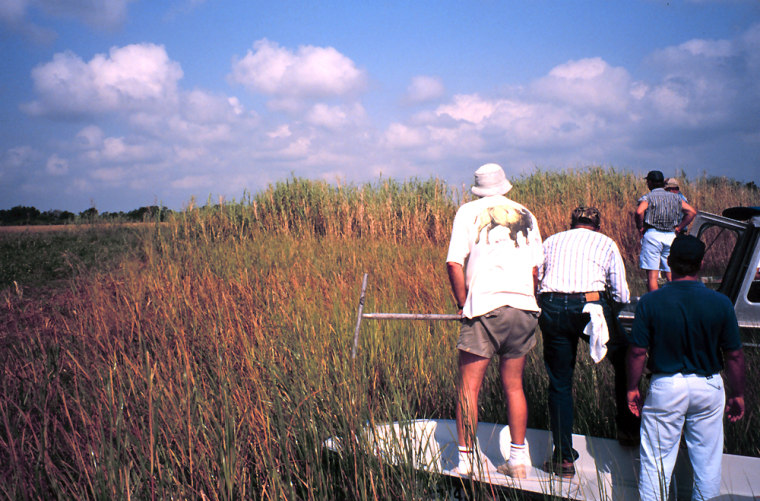The very technology that protects New Orleans from flooding has backfired, environmental experts say.
They say the levees that ring the city have led to the rapid decay of nearby wetlands during the past century, removing a crucial buffer zone that once protected the area from hurricanes.
Hurricanes quickly lose force when they hit land, but New Orleans is now vulnerable to violent storms because the land around it has been rapidly disappearing. Today, New Orleans is almost completely exposed to the Gulf of Mexico, said Val Marmillion, a consultant for the America's Wetland group, which is lobbying for the Louisiana coast area.
"There are almost open water conditions around New Orleans now," Marmillion said. "Because of wetland loss some areas of Louisiana are no longer protected at all."
Wetlands act as a "speed bump," slowing down storms almost like dry land does, said Kip Patrick, spokesman for America's Wetland. "They take some of the brunt of the force of the hurricane, weakens the storm like any land mass would."
Sidney Coffee, executive assistant to the governor for coastal activities, said about 1,900 square miles of wetlands have disappeared from the area since the 1930s, and the receding continues at a rate of about 24 square miles per year. The erosion has a direct impact on New Orleans' ability to absorb the blow of a storm like Katrina, she said. For every 2.7 miles of wetlands, storm surges are reduced by about one 1 foot, she said.
"We've tried and tried and tried to tell people this is real, this is happening. This is happening a little bit every day," she said. "But it's a real emergency."
Area residents can see the effects of decreased wetlands even with large thunderstorms, she said. Some area highways now flood regularly just from the day's high tide, she said.
“We've lost so much of (the wetlands), it puts cities at greater and greater risk," Coffee said.
Several factors — most human-made — have contributed to the steady decline of the delta at the bottom of the Mississippi. But most of the erosion is blamed on the levees, which faithfully steer all the water from the Mississippi into the Gulf of Mexico. That prevents occasional flooding, keeping area residents above water most of the time. But one unforeseen consequence of the levees has been to cut off wetlands from their life force.
The regular floods served nature's purpose by feeding the delta, bringing fresh water and sediment that served to sustain life and replenish the wetlands. Without the regular flooding, the wetlands naturally “compact.”
“Simply put, when the land does not have any nutrients and fresh water it dies,” Marmillion said.
Fixing the problem will be costly and time consuming. Area citizens regularly donate old Christmas trees which are strategically placed in the marshes to help retain sediment, but the effort is largely symbolic, Coffee said.
“The entire area has to be re-plumbed,” she said. “You have to build on what you have. It's a very complex solution."
About $14 billion is needed for a variety of projects, including diverting river water and manually depositing sediment. Even still, it’ll take about 20 years to reverse the effects erosion, she said.
So far, only a tiny portion of those funds are being spent. The recent energy bill passed by Congress contains about $540 million to start anti-erosion projects. Another $2 billion, earmarked for Army Corp of Engineers projects, has been proposed as part of a water resources bill currently making its way through Congress.
“This is a very intense effort that would go on to do this,” she said. “But the costs of not doing it are far greater.”
